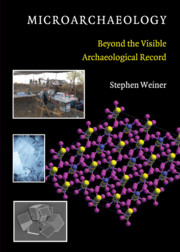Book contents
- Frontmatter
- Contents
- Preface
- 1 Archaeology, Archaeological Science, and Microarchaeology
- 2 Information Embedded in the Microscopic Record
- 3 Completeness of the Archaeological Record
- 4 Common Mineral Components of the Archaeological Record
- 5 Biological Materials: Bones and Teeth
- 6 Biological Materials: Phytoliths, Diatoms, Eggshells, Otoliths, and Mollusk Shells
- 7 Reconstructing Pyrotechnological Processes
- 8 Biological Molecules and Macromolecules: Protected Niches
- 9 Ethnoarchaeology of the Microscopic Record: Learning from the Present
- 10 Absolute Dating: Assessing the Quality of a Date
- 11 Reading the Microscopic Record On-Site
- 12 Infrared Spectroscopy in Archaeology
- Appendix A Identifying Minerals Using Microchemical Analysis
- Appendix B Identifying Minerals and Compounds Using Infrared Spectra: Table of Standard Minerals and Compounds for Which Infrared Spectra Are Available
- References
- Index
- Plates section
Appendix B - Identifying Minerals and Compounds Using Infrared Spectra: Table of Standard Minerals and Compounds for Which Infrared Spectra Are Available
Published online by Cambridge University Press: 05 June 2012
- Frontmatter
- Contents
- Preface
- 1 Archaeology, Archaeological Science, and Microarchaeology
- 2 Information Embedded in the Microscopic Record
- 3 Completeness of the Archaeological Record
- 4 Common Mineral Components of the Archaeological Record
- 5 Biological Materials: Bones and Teeth
- 6 Biological Materials: Phytoliths, Diatoms, Eggshells, Otoliths, and Mollusk Shells
- 7 Reconstructing Pyrotechnological Processes
- 8 Biological Molecules and Macromolecules: Protected Niches
- 9 Ethnoarchaeology of the Microscopic Record: Learning from the Present
- 10 Absolute Dating: Assessing the Quality of a Date
- 11 Reading the Microscopic Record On-Site
- 12 Infrared Spectroscopy in Archaeology
- Appendix A Identifying Minerals Using Microchemical Analysis
- Appendix B Identifying Minerals and Compounds Using Infrared Spectra: Table of Standard Minerals and Compounds for Which Infrared Spectra Are Available
- References
- Index
- Plates section
Summary
Several complementary approaches can be useful for identifying the materials being analyzed. Perhaps the most powerful approach is to use the “search” option present in most infrared software packages and compare the unknown sample spectrum to spectra in a reference library. For this reason, the infrared spectral library of the Kimmel Center for Archaeological Science, Weizmann Institute of Science, is posted on the Web (http://www.weizmann.ac.il/kimmel-arch/islib.html). The materials in the library are listed in Table B.1. This list is also a simple “classification” of archaeologically relevant compounds. Note, too, that it contains minerals produced by organisms, many of which are less relevant to archaeology but more relevant to the field of biomineralization. Other useful libraries are available, such as that of the Infrared and Raman Users Group (http://www.irug.org/).
Perhaps the major problem with using search software for material identification is that peak positions are not invariant; rather, they depend on the local structural environment, counterions, and probably many other factors. This makes it difficult to know when a match can be accepted with confidence. A second problem relates to identifying mixtures of compounds. In this case, the library search can be focused on key peaks that are indicative of a particular compound.
- Type
- Chapter
- Information
- MicroarchaeologyBeyond the Visible Archaeological Record, pp. 320 - 326Publisher: Cambridge University PressPrint publication year: 2010



